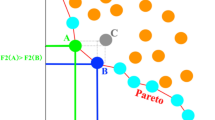Abstract
Considering how the resolution of conflicts changes over time is an aspect of multiobjective optimization that is not commonly explored. These considerations embody changes in both the preferences that dictate the selection of Pareto designs, and changes in the Pareto frontier itself over time, or s-Pareto frontier when a set of disparate design concepts are considered. As such, this paper explores the idea of dynamic s-Pareto frontiers and preferences. Specifically, this paper presents a dynamic multiobjective optimization problem formulation that provides a framework of identifying the s-Pareto frontier for a series of time steps. The application of the presented dynamic formulation is illustrated through a simple aircraft design example. Through this example it was observed that the identification of the dynamic s-Pareto frontier enabled the observation of the impact of design decisions on the offset of selected designs from the identified dynamic frontier. By measuring and minimizing the aircraft design offset, the selected aircraft design offset was improved by an average of roughly 60 % from the next best selected alternative identified using traditional selection methods.



Similar content being viewed by others
Abbreviations
- μ :
-
Vector of design objectives
- x :
-
Vector of design variables/objects
- y :
-
Vector of independent design objects
- z :
-
Vector of dependent design objects
- n [ ] :
-
indicates the number of [ ]
- [ ] l :
-
indicates the lower limit of [ ]
- [ ] u :
-
indicates the upper limit of [ ]
- [ ]∗ :
-
indicates the optimal value of [ ]
References
Blackwell T, Branke J (2004) Multi-swarm optimization in dynamic environments. Lecture Notes in Computer Science, vol 3005. pp 489–500. doi:10.1007/978-3-540-24653-4_50
Bowman MW (1999) Lockheed C-130 Hercules Crowood Press, Ramsbury, pp 4–54
Cheng FY, Li D (1996) Multiobjective optimization of structures with and without control. J Guid Control Dyn 19(2):392–397
Curtis SK, Mattson CA, Hancock BJ, Lewis PK (2013) Divergent exploration in design with a dynamic multiobjective optimization formulation. Struct Multidiscip Optim 47(5):645–657
Faulkenberg SL, Wiecek MM (2010) On the quality of discrete representations in multiple objective programming. Optim Eng 11:423–440. doi:10.1007/s11081-009-9099-x
Gardenghi M, Wiecek MM (2011) Efficiency for multiobjective multidisciplinary optimization problems with quasiseparable subproblems. Optim Eng, 293–318. doi:10.1007/s11081-011-9136-4
Hatzakis I, Wallace D (2006) Dynamic multi-objective optimization with evolutionary algorithms: a forward-looking approach. In: Proceedings of the 8th annual conference on Genetic and evolutionary computation, GECCO ’06, New York, NY, USA, ACM, New York, pp 1201–1208. ISBN:1-59593-186-4. 10.1145/1143997.1144187
Heintz C (2002) Aircraft design made easy. EAA Exp. http://www.zenithair.com/images/kit-data/ht.html
Kasprzak EM, Lewis KE (2000) An approach to facilitate decision tradeoffs in Pareto solution sets. J Eng Valuat Cost Anal 3:173–187
Khire RA, Messac A (2008) Selection-integrated optimization (SIO) methodology for optimal design of adaptive systems. J Mech Des 130(10):101401
Lewis PK (2012) An optimization-based method of traversing dynamic s-Pareto frontiers. PhD thesis, Brigham Young University
Lewis PK, Mattson CA (2012) A method for developing systems that traverse the Pareto frontiers of multiple system concepts through modularity. Struct Multidiscip Optim 45(4):467–478. doi:10.1007/s00158-010-055501
Lewis PK, Murray VR, Mattson CA (2011) A design optimization strategy for creating devices that traverse the Pareto frontier over time. Struct Multidiscip Optim 43(2):191–204. doi:10.1007/s00158-010-0555-1
Messac A (2000) From dubious construction of objective functions to the application of physical programming. AIAA J 38(1):155–163
Messac A, Mattson CA (2002) Generating well-distributed sets of Pareto points for engineering design using physical programming. In: Optimization and engineering, vol 3. Kluwer Academic, Norwell, pp 431–450
Messac A, Puemi-Sukam C, Melachrinoudis E (2000) Aggregate objective functions and Pareto frontiers: required relationships and practical implications. Optim Eng 1:171–188
Miettinen KM (1999) Nonlinear multiobjective optimization. International series in operations research & management science. Kluwer Academic, Norwell, pp 5–36
Nigam N, Kroo I (2008) Control and design of multiple unmanned air vehicles for a persistent surveillance task. In: 12th AIAA/ISSMO multidisciplinary analysis and optimization conference, Victoria, British Columbia, Sep. 10–12, pp 1–14. Number AIAA-2008-5913
Olewnik A, Brauen T, Ferguson S, Lewis K (2004) A framework for flexible systems and its implementation in multiattribute decision making. J Mech Des 126(3):412–419
Siddiqi A, de Weck OL (2008) Modeling methods and conceptual design principles for reconfigurable systems. J Mech Des 130:101102
Simpson TW (1998) Product platform design and optimization: status and promise. Artif Intell Eng Des Anal Manuf 18(1):3–20
Smith PC (2001) Lockheed C-130 Hercules: the World’s favourite military transport. Crowood, Wiltshire, pp 12–140
Trautmann H, Mehnen J (2009) Preference-based Pareto optimization in certain and noisy environments. Eng Optim 41(1):23–38. doi:10.1080/03052150802347926
Yang TG, Beiter KA, Ishii K (2004) Product platform development: an approach for products in the conceptual stages of design. In: 2004 ASME international mechanical engineering congress and RDD expo, pp 97–108. Number IMECE2004-62171
Yun Y, Yoon M, Nakayama H (2009) Multi-objective optimization based on meta-modeling by using support vector regression. Optim Eng 10:167–181. doi:10.1007/s11081-008-9063-1
Acknowledgements
Funding for this research was provided by the National Science Foundation Grant 0954580.
Author information
Authors and Affiliations
Corresponding author
Appendix A: Dynamic s-Pareto formulation inputs
Appendix A: Dynamic s-Pareto formulation inputs
For the aircraft example given in this paper there are three concepts. The variable values for these different concepts are presented in Tables 6, 7 and 8, and were selected using data provided in Heintz (2002) for various aircraft and wing configurations. The units and descriptions of these variables are given in Table 4. The rows of the tables at each time-step are the values of the diagonal matrix (\(w^{(k^{(t)})}\)) and design object limits (\(x^{(k^{(t)})}_{l}\), \(x^{(k^{(t)})}_{u}\)) for the corresponding concept. For example, the rows corresponding to χ i,i , x l , and x u for Concept 1 at t=1 represent the \(\chi^{(1^{(1)})}_{i,i}\) values of Eq. (5), \(x^{(1^{(1)})}_{l}\) values of Eq. (3), and \(x^{(1^{(1)})}_{u}\) values of Eq. (3), respectively.
Rights and permissions
About this article
Cite this article
Lewis, P.K., Tackett, M.W.P. & Mattson, C.A. Considering dynamic Pareto frontiers in decision making. Optim Eng 15, 837–854 (2014). https://doi.org/10.1007/s11081-013-9238-2
Received:
Accepted:
Published:
Issue Date:
DOI: https://doi.org/10.1007/s11081-013-9238-2




